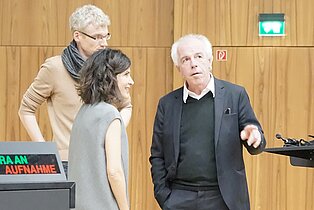Farshid Moussavi | Farshid Moussavi Architecture | London
November Talks 2016 in Stuttgart
Farshid Moussavi, the third speaker at the November Talks in Stuttgart, lectures at renowned universities such as the Architectural Association (AA) in London and the Harvard Graduate School of Design in Cambridge, MA. She is an architectural theorist and recently published her third book.
That is remarkable for an architect who also sets standards in practice and currently runs her second successful office – Farshid Moussavi Architects. She made a name for herself with Foreign Office Architects – FOA, which she founded in 1993, and in particular with the Yokohama ferry terminal that was completed in 2002. The unusual wooden deck of the infrastructure project received an enthusiastic reception from experts and remains a reference project to this day, which Farshid Moussavi was happy to mention during her lecture at the University of Stuttgart.
But first she provided an insight into her new book "The Function of Style". She described how the question about style is getting lost in a contemporary debate on architecture because style only seems to serve formal goals. A constantly changing world demands that the concepts and methods of architectural practices have to be re-evaluated, newly defined and adapted constantly. As an example for this, the London-based Moussavi pointed to Brexit, which suddenly led to projects having to be reconsidered, certain materials no longer being available and international cooperation becoming more difficult. Moussavi advocates redefining the term "style" as well and believes that this would help with contemporary building and designing.
What is the function of style?
In the era of open source and internationalisation, style can no longer be an expression of authorship and nation states. Moussavi also believes that even naming a style after the era and epoch when it began is outdated. Instead, she proclaims the return to the architectural base element and underscores the micropolitical decision of architects, which they make every time they rearrange these base elements. According to Farshid Moussavi, the effects and consequences of architectural decisions, such as flexibility, privacy or transparency, are what constitute "style", and this style has to be consciously shaped and designed. She meticulously and precisely analyses walls, windows, balconies, ceilings, etc. and examines the different effects that different architectural decisions could have on users and their behaviour.
Trivial? Not at all! It becomes exciting for the audience when the speaker applies this "basic architectural research" to her practical experience and, using selected details, precisely explains which considerations were involved in the respective architectural setting. She promotes an architecture of assemblage, of addition and, in the process, to make a specific decision with each new component in order to remain reactive in a present dictated by change. She believes this way of designing is more sustainable and resilient than one structure-dictating design idea that then has to be implemented consistently down to the smallest detail. "That is why I love working drawings! They are filled with important architectural decisions", said Farhid Moussavi at the end of her theoretical introduction, and then used a few projects – often with construction site photos – to demonstrate what this approach means in practice.
Residential building in Montpellier
She explains the idea of a specifically composed building (assemblage) by using the example of a nine-storey apartment tower in the southern French city of Montpellier. The building had to meet two objectives: Flexibility of the ground plans and maximum privacy in the exterior. While a basic variance of the blossom-shaped ground plans due to a utility room at the core of the building and the absence of columns is easily comprehensible, Moussavi explained the maximum privacy of the circumferential balconies in great detail. From each of the three types of balconies that were used, the potential lines of sight to neighbours were closely examined. The alignment of the bent balconies changes depending on each storey and ends up as a softly curved facade. This opens up the view of the landscape and avoids the use of separating walls between balconies. Critical zones, from which nosy looks could still be cast onto the balconies of neighbours, are "defused" with a specifically adapted, tight grating of the railings.
Museum of Contemporary Art in Cleveland
In Cleveland, the firm designed a museum for contemporary art also referred to as MOCA. In this case, the wish for flexibility of use was the starting point for the work of FMA. A crystal-like building, which allows for different scenarios thanks to a ground plan featuring multiple entrances, rises from a hexagonal area. The rooms have multiple functions. They can be connected or rented out separately. With just a little work, the museum shop can be turned into a showroom for dancing performances. FMA turned the requirement of an enclosed emergency staircase into an opportunity. While the representative open staircase is supposed to foster communication and lead to the different gallery levels, a second staircase is hidden behind it. It is supposed to provide visitors with a contemplative place and a visual and acoustic break between exhibits. The building features a reflecting stainless steel facade. However, as a result of slight dents in the lamellar panels, distortions are created: Like a kaleidoscope, the environment is reflected but also transformed.
Office tower in London
The lecture was concluded with the presentation of a 17-storey office tower in i London with an irregular octagon as its base. Due to the neighbouring buildings, the tower is always just partially visible but it should still be perceived as one of the city's striking objects. As a special detail, the architect therefore explains the uniform facade – a curtain of black glass panels that is based on a three-metre grid divided into small segments. The concave windows allow different levels of translucence and different views. Overall, however, they still create a cohesive look.













